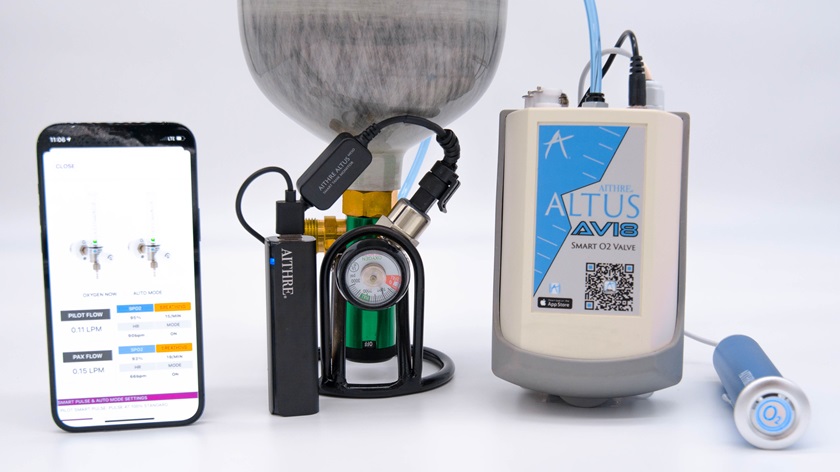Oxygen measured as delivered
Portable product increases supplemental oxygen endurance
The earliest portable supplemental oxygen systems made with general aviation in mind pushed out this vital brain fuel at a steady rate, without regard to demand. Today’s pilots need not waste their supplemental oxygen during periods of low demand; there’s even an app for that.
A pulse oximeter (sold separately) linked to an iOS device enabled the AVI8 to throttle oxygen delivery and maintain Ruttler’s blood oxygen saturation at or above 92 percent throughout the flight, the company reported. That critical indication of oxygenation (a useful proxy for pilot cognitive capacity) actually climbed with the aircraft established at that thinly oxygenated altitude, “demonstrating that the AVI8 was properly titrating the dosage of oxygen in real-time.”
Titration is facilitated by optical flow measurement of the oxygen as it is delivered to each connected cannula, an accurate means of calculating the precise volume of a gas flowing through a tube, and that feature is a first for portable supplemental oxygen products, the company said.
The AVI8 system, composed of a carbon fiber cannister that holds 152 liters of oxygen compressed to 2,000 psi that accounts for most of the system’s six-pound weight, delivers oxygen exactly as required, wasting hardly a molecule and increasing the system’s endurance beyond that of the largest available portable tanks with more traditional delivery systems—up to 12 hours of use time.
The AVI8 includes the cannister, the gas regulator, and a low-pressure delivery control system that links to the Aithre Connect iOS/WatchOS app, which provides basic controls and additional features such as the recently added emergency mode that pushes delivery through (up to two) nasal cannulas up to 12 liters per minute, useful when carbon monoxide in the cabin is competing with oxygen for slots in your circulatory system. This high flow is also dialed up automatically if carbon monoxide levels exceed 50 parts per million, or if the pilot’s oxygen saturation falls below 85 percent. It also kicks in automatically if the aircraft climbs into Class A airspace.
At lower altitudes, the system calculates demand and flow based on the data collected in real time by the connected Aithre Illyrian Smart Oximeter ($130 on the company website, and also available from various retailers). The AVI8 with two-place distribution system (cannulas, independent valves and controls) and carrying bag is priced at $1,395 on the company website. This system can be used in experimental aircraft without further approvals or paperwork, though it ships with an empty oxygen cannister while the company awaits a permit to ship the system with the first fill of oxygen included. A wireless pressure gauge is also included in the package.
A rubber mount with a hook-and-loop strap is also included, and the cannister can be mounted up to 15 feet from the cannulas. An optional plumbing kit for experimental aircraft includes a bulkhead fitting for baggage compartment mounting, and behind-the-panel plumbing.





